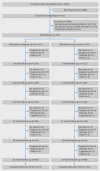Stepped care for depression and anxiety in visually impaired older adults: multicentre randomised controlled trial
- PMID: 26597263
- PMCID: PMC4655616
- DOI: 10.1136/bmj.h6127
Stepped care for depression and anxiety in visually impaired older adults: multicentre randomised controlled trial
Erratum in
-
Stepped care for depression and anxiety in visually impaired older adults: multicentre randomised controlled trial.BMJ. 2016 Apr 6;353:i1995. doi: 10.1136/bmj.i1995. BMJ. 2016. PMID: 27052324 No abstract available.
Abstract
Study question: Is stepped care compared with usual care effective in preventing the onset of major depressive, dysthymic, and anxiety disorders in older people with visual impairment (caused mainly by age related eye disease) and subthreshold depression and/or anxiety?
Methods: 265 people aged ≥50 were randomly assigned to a stepped care programme plus usual care (n=131) or usual care only (n=134). Supervised occupational therapists, social workers, and psychologists from low vision rehabilitation organisations delivered the stepped care programme, which comprised watchful waiting, guided self help based on cognitive behavioural therapy, problem solving treatment, and referral to a general practitioner. The primary outcome was the 24 month cumulative incidence (seven measurements) of major depressive dysthymic and/or anxiety disorders (panic disorder, agoraphobia, social phobia, and generalised anxiety disorder). Secondary outcomes were change in symptoms of depression and anxiety, vision related quality of life, health related quality of life, and adaptation to vision loss over time up to 24 months' follow-up.
Study answer and limitations: 62 participants (46%) in the usual care group and 38 participants (29%) from the stepped care group developed a disorder. The intervention was associated with a significantly reduced incidence (relative risk 0.63, 95% confidence interval 0.45 to 0.87; P=0.01), even if time to the event was taken into account (adjusted hazard ratio 0.57, 0.35 to 0.93; P=0.02). The number needed to treat was 5.8 (3.5 to 17.3). The dropout rate was fairly high (34.3%), but rates were not significantly different for the two groups, indicating that the intervention was as acceptable as usual care. Participants who volunteered and were selected for this study might not be representative of visually impaired older adults in general (responders were significantly younger than non-responders), thereby reducing the generalisability of the outcomes.
What this study adds: Stepped care seems to be a promising way to deal with depression and anxiety in visually impaired older adults. This approach could lead to standardised strategies for the screening, monitoring, treatment, and referral of visually impaired older adults with depression and anxiety.
Funding, competing interests, data sharing: Funded by ZonMw InZicht, the Dutch Organisation for Health Research and Development-InSight Society. There are no competing interests. Full dataset and statistical code are available from the corresponding author.Study registration www.trialregister.nl NTR3296.
© van der Aa et al 2015.
Conflict of interest statement
Competing interests: All authors have completed the ICMJE uniform disclosure form at
Figures


References
-
- World Health Organization. Global data on visual impairments 2010. www.who.int/blindness/GLOBALDATAFINALforweb.pdf?ua=1.
-
- Evans JR, Fletcher AE, Wormald RP. Depression and anxiety in visually impaired older people. Ophthalmology 2007;114:283-8. - PubMed
-
- Augustin A, Sahel JA, Bandello F, et al. Anxiety and depression prevalence rates in age-related macular degeneration. Invest Ophthalmol Vis Sci 2007;48:1498-503. - PubMed
-
- Van der Aa HPA, HC Comijs, BWJH Penninx, GHMB van Rens, RMA van Nispen. Major depressive and anxiety disorders in visually impaired older adults. Invest Ophth Vis Sci 2015;56:849-54. - PubMed
Publication types
MeSH terms
Associated data
LinkOut - more resources
Full Text Sources
Other Literature Sources
Medical
